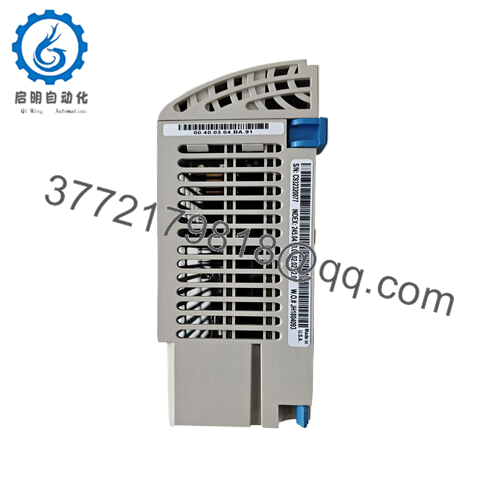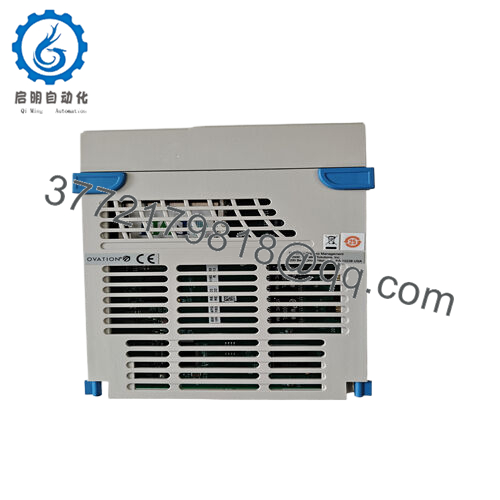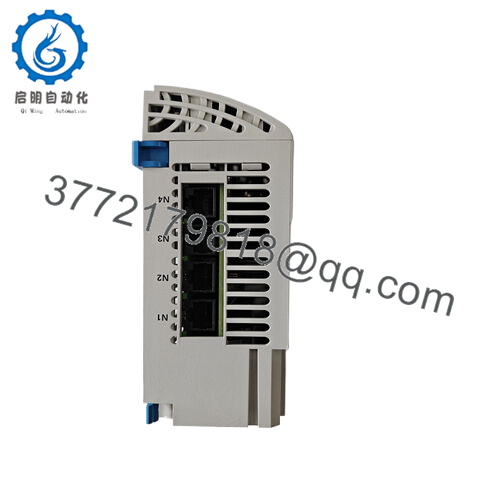Description
What This Product Solves
In the mission-critical sphere of power generation and distributed process control, orchestrating vast arrays of sensors, actuators, and interlocks demands a controller that executes intricate algorithms with unerring timing—yet in sprawling Ovation DCS installations, legacy processors often lag under the weight of 10,000+ point scans or stutter during transients like grid faults, spawning delayed responses that misalign turbine governors or flood chemical dosing, ultimately risking equipment strain and regulatory non-compliance in NERC-audited plants where sub-second determinism is the line between stability and shutdown. These bottlenecks sharpen during system expansions, where hybrid I/O branches multiply without proportional compute headroom, forcing engineers to cobble workarounds like offloading scans that dilute real-time fidelity and inflate engineering hours on tuning overrides.
- 5X00481G04
The Emerson 5X00481G04 confronts this as the OCR1100 Controller CPU Module, a high-efficiency brain for Ovation platforms engineered to juggle up to 32,000 I/O points with seamless failover in redundant pairs, ensuring your control strategies unfold without the hiccups that erode loop performance. It proves pivotal in modernizing legacy WDPF setups or scaling remote nodes in water treatment basins, where modular integration hinges on CPUs that plug into CompactPCI backplanes without firmware upheavals. For those navigating high-reliability industrial automation, this module intervenes when standard controllers choke on sequential and modulating blends, delivering the cycle-precise I/O signal processing that sustains process integrity across vibration-stressed enclosures.
Consider a combined-cycle plant where the CPU must fuse vibration trends with fuel valve commands in 20ms cycles to preempt overspeeds, or a wastewater lift station where DNP3 polling must sync with level cascades amid pump surges—the Emerson 5X00481G04 thrives, leveraging Intel architecture and Ovation’s algorithm library to preempt bottlenecks with predictive buffering. In these process control pressure cookers, it trims the validation burden of custom accelerators, channeling diagnostics to the HMI for at-a-glance health that flags overloads early. At root, this CPU module recasts orchestration from a compute constraint to a capability catalyst—nurturing the scalability and fault tolerance that fortifies uptime, while smoothing the glide to advanced analytics in your DCS evolution where every tick drives dispatchable reliability.
How the Product Works & Fits into a System
The Emerson 5X00481G04 pulses as the executive core in Ovation’s control stratum, harnessing an Intel processor on a CompactPCI form factor to run the real-time Ovation kernel, scanning up to 32,000 points across 16 I/O branches while arbitrating peer-to-peer IONet traffic for redundant synchronization—executing control sheets from the Ovation library with <10ms latency, complete with data acquisition from analog loops and sequential logic for interlock chains, all while sipping 50W from the backplane to sustain through voltage dips. It boots from flash, loads configurations via Ethernet, and employs watchdog circuits that trigger failovers to a mated unit in under 100ms, preserving scan continuity without recipe reloads.
Anchored at the summit of your DCS hierarchy, it resides in a controller chassis, interfacing via fiber IONet to remote cabinets up to 10km out and local buses to Q-Line I/O modules, supporting hot-swappable redundancy where primary/secondary pairs vote on outputs for bumpless transfer in ring topologies. Protocol fluency spans Modbus, DNP3, and Ovation-native for SCADA fusion, tunable through Developer Studio to prioritize critical paths like boiler safeguards over archival dumps.
Health monitoring weaves in natively: front LEDs for CPU load, network sync, and fault states, with embedded relays that assert on thermal excursions, streaming metrics to the historian for trend-based prognostics—no ancillary probes required. In a layered ecosystem, it crowns the IONet fabric, upstream of power entries and downstream of field terminations, weaving a resilient tapestry for multivariable coordination—like in a hydro governor where it blends speed feedback with wicket gate pulses for precise load following. For a substation retrofit, the Emerson 5X00481G04 would marshal breaker status polls, buffering transients from arc flashes to keep phasor estimates sharp. This innate alignment curtails boot-time rituals, framing it as the sagacious conductor in your control concerto, melding I/O influx with algorithmic aplomb for attuned, anomaly-proof autonomy.
| Specification | Details |
|---|---|
| Model Number | 5X00481G04 |
| Brand | Emerson |
| Type | OCR1100 Controller CPU Module |
| Input Voltage | 5 VDC / 24 VDC (backplane) |
| Operating Temp Range | -20°C to +65°C |
| Mounting Style | CompactPCI Backplane Slot |
| Dimensions | 4.1 x 15.9 x 10.8 cm |
| Weight | 0.3 kg |
| Interface/Bus | IONet Fiber, CompactPCI Local Bus |
| Compliance | CE, UL, CSA, RoHS |
| Supported Protocols | Modbus, DNP3, Ovation Native |
| Typical Power Draw | 50 W |
Real-World Benefits
Integrating the Emerson 5X00481G04 empowers your Ovation deployments with a CPU tuned for the inexorable tempo of grid-scale ops, where its Intel backbone and kernel optimizations yield 2-3x scan throughput over prior gens—unlocking finer-grained control like 1ms resolution on sequence events, which sharpens overspeed protections in gas turbines and trims fuel variability by 0.5% without the lag that prompts detuned margins. This alacrity isn’t standalone; it infuses strategies, enabling layered analytics that correlate vibration with load profiles for preemptive derates, distilling outage risks into routine optimizations across quarterly dispatches.
Control room crews capitalize on its transparency, as IONet health pings and CPU utilization histograms surface bottlenecks in the executive view—envision a load dispatcher spotting a scan queue swell from I/O bloom, reallocating via config tweaks mid-peak sans failover fuss. The module’s chassis-agnostic fit eases engineering loads, with pin-compatible upgrades that sidestep recertification in brownfield plants, hastening expansions where point counts surge and timelines tighten. Over a decade’s duty, it enshrines performance steadiness with a MTBF beyond 200,000 hours, its shielded PCB fending EMI in switchyards, so your controller cadre accrues acuity absent the upkeep of frequent firmware forays.
Broader, the Emerson 5X00481G04 lubricates growth by virtualizing branches in the network map, so I/O proliferations unfold as database deltas rather than hardware hauls—priming for edge AI where CPU cycles stoke predictive models on anomaly clusters. These symbiotic savings recast central processing from a throughput toll to a throughput tonic, paring total system spends while elevating the DCS’s mantle as your plant’s prescient pulse.
Typical Use Cases
The Emerson 5X00481G04 commands in thermal powerhouses, slotting into Ovation chassis to helm combustion controls on supercritical boilers, where its 32k-point prowess fuses flame scanner data with air damper sequencing amid 1000°C drafts—bedrock for process control environments stabilizing NOx curves, shoring critical system uptime through ramp-ups or fuel switches in 500MW blocks. In these inferno-intense halls, its failover fabric upholds high reliability, provisioning scan fidelity that dodges flameouts and emissions excursions.
Nuclear simulators enlist it for virtual reactor kinetics, arbitrating neutron flux models and rod worth calcs under mock scram pulses and thermal hypotheticals, backing continuous uptime where fast data cycles from virtual sensors dictate training fidelity and recert intervals. Harsh sim environs and data deluges probe its buffers, yet it metes out deterministic ticks for seamless scenario spins.
In oil sands upgraders, the Emerson 5X00481G04 pilots hydrocracker loops, syncing coker drum levels with hydrogen quench valves over DNP3 ties—pivotal for used in bitumen conversion where point density forestalls coke buildup and throughput troughs. Across fossil fuels, nuclear training, and heavy oil processing, this CPU galvanizes applications thirsting for compute command in cauldron conditions, transmuting scan surges into strongholds of stratified sovereignty.
5X00481G01 – Earlier OCR1100 variant for basic scan loads in legacy ties.
5X00481G03 – Mid-rev with expanded memory for denser I/O branches.
1C31181G01 – Remote node controller companion for IONet extensions.
5X00105G01 – Analog input module optimized for OCR1100 pairings.
1C31203G01 – Distributed I/O aggregator for scaled point architectures.
R4009 – Higher-end CPU for ultra-high point counts in enterprise DCS.
1C31194G03 – Legacy WDPF bridge for Westinghouse-to-Ovation CPU migrations.
Before enshrining the Emerson 5X00481G04 in your CompactPCI cage, equilibrate its kernel build with the IONet fabric via the Ovation validator—version veers can stall peer syncs, stranding your branches in broadcast limbo. Palpate the bus fingers for patina or pitches from shelf stasis; a mylar wipe and ohm-out below 0.1Ω thwarts arbitration asymmetries that skew scan priorities. Thermal latitude leans on a chassis fan audit to affirm 150 CFM over the sink, notably in vaults cresting 50°C where I/O heat harmonics—mock your point tally to certify. Pre-net the fiber with a OTDR at 1310nm, nailing <0.5dB loss, and single-point the frame ground to shunt induced noise from nearby gensets.
Afield, stewardship skews prophetic over plodding. Biweekly executive scans for queue depths—nominal <20% utilization heralds harmony, but swells summon a point cull with the mapper. Quarterly card ejections with ESD gauntlets and alcohol ablutions on gold edges exile oxide veils from humid hauls; re-dock at 0.8 Nm to buck vibe vectors. Annually, onslaught with emulated loads via the simulator to attest 99.99% determinism across failover flips, archiving latencies for load-line lapses. If stalls surface, summon Ovation’s remote kernel dissector over VPN, but these pulses pose the Emerson 5X00481G04 as a scan sovereign, routing rigor to runes over repairs.







 WhatsApp: +86 16626708626
WhatsApp: +86 16626708626 Email:
Email:  Phone: +86 16626708626
Phone: +86 16626708626


